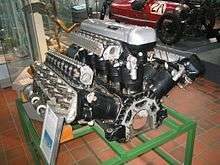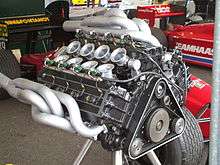W12 engine

A W12 engine is a twelve cylinder piston internal combustion engine in a W configuration. W12 engines have been manufactured in two distinct configurations. The original W12 configuration used three banks of four cylinders coupled to a common crankshaft, with 60° angles between the banks. These were used in several aircraft engine designs from the 1920s, notably the Napier Lion and various French engines. The more recent configuration, used in the Volkswagen Group W12, uses four rows of three cylinders merged into two 'cylinder banks' (two narrow-angle VR6 engine blocks), coupled to a common crankshaft.[1]
Aircraft engines (three-bank)
Napier Lion
The Napier Lion was a broad arrow-style W12 engine produced by Napier at Acton, West London, from 1917 to the late 1930s. This mostly alloy engine had a capacity of 24 litres (1,465 cu in) and produced from 450 to 900 horsepower (336 to 671 kW; 456 to 912 PS). It was used in many racing cars by John Cobb and Malcolm Campbell, racing aircraft such as the Supermarine S.5 Schneider Cup winner, and speed boats such as Hubert Scott-Paine's Miss Britain III.
Other Broad Arrow aircraft engines
The 500 hp (373 kW) Farman 12We was one of their best selling engines in the 1920s. They also built a W18.
Lorraine manufactured their 12E Courlis aircraft engine in the 1920s and 1930s.
Sunbeam built a prototype W12 called the "Kaffir", based on their Arab V8 engine.
Motor racing engines (three-bank)
In the late 1980s, two W12 engines were designed and built for use in Formula One.
MGN
In France, Guy Negre produced the MGN which had three banks of four cylinders offset so that each crankpin accommodated three connecting rods side-by-side. The MGN also had a novel system of cylindrical rotary valves located at the top of the combustion chambers, making the engine notably compact. The engine was tested in an AGS Formula One car, and in a Norma sports car, but never raced.
Life F35
The other W12 Formula One engine was the Life F35 built in Italy by Life Racing Engines. The chief engineer for this project was Franco Rocchi, who had already designed and built an experimental 498 cubic centimetres (30.4 cu in) W3 engine when he was at Ferrari in 1967 as an investigation into the viability of a W18 F1 engine.[2] Rocchi's W3 engine used a central master connecting rod, with a slave rod locating onto each side of the master rod, rather than directly onto the crank pin. This meant that there was no offset between the cylinders, and the crankpin did not have to be unusually long. A similar arrangement was employed for the Life W12 engine.[2] Life Racing Engines failed to attract the interest of an existing team, so they acquired an F1 chassis which had been built for another team and tried to enter F1 on their own account in 1990. The engine proved to be unreliable and lacking in power.[2][3] The car never got out of prequalifying in 14 attempts.[3]
Audi Avus show car (three-bank)
The Audi Avus prototype was shown at the 1991 Tokyo Motor Show.[4] The engine was described as a traditional W12 with three banks of four cylinders each set at 60° to each other. The DOHC W12 engine was said to produce 509 hp (380 kW) at 5800 rpm.[5]
Volkswagen Group W12

At the 2001 Tokyo Motor Show, Volkswagen Group showcased a prototype Volkswagen Nardò W12 Coupé, a mid-engined, rear-wheel drive supercar powered by a 6.0 litre W12 engine, producing 600 horsepower (447 kW; 608 PS). A week before, the W12 Coupe broke the 24‑hour world endurance record. A total distance of 7,085.7 kilometres (4,402.8 mi) was covered at an average speed of 295.24 kilometres per hour (183.45 mph), breaking the old record by 12 kilometres per hour (7.5 mph). Production of the W12 Coupé was considered, but was subsequently cancelled.
Volkswagen Group currently produces W12 engines. It is constructed by mating two narrow-angle 15° VR6 engines at an inclined angle of 72°.[1] The narrow angle of each set of cylinders allows just two overhead camshafts to drive each pair of banks, so just four are needed in total. Note that this design differs from the W18 engine that Volkswagen Group produced for its Bugatti concept cars of 1998 and 1999. Due to this distinction, the Volkswagen Group's W12 engine is sometimes described as a "WR12".
The advantage of the W12 engine is its compact packaging, allowing Audi to build a 12-cylinder sedan with all-wheel drive, whereas a conventional V12 engine could only have a rear-wheel drive configuration as it would have no space in the engine bay for a differential and other components required to power the front wheels. The 6.0L W12 in the Audi A8L W12 (only offered in the long-wheelbase models) appears slightly smaller overall than the 4.2L V8 that powers the Audi A8 4.2 variants. [6] However the W12 engine is not as smooth as the V12.
The 2011 Audi A8L W12 debuted a revised 6.3 litre directly-injected version of the W12 (WR12) engine with 500 PS.
The Volkswagen Group W12 engine is used in some high-end luxury models:
- Audi Avus quattro (concept version only)
- Audi A8L W12[7]
- Bentley Continental GT
- Bentley Continental Flying Spur[8][9]
- Bentley Bentayga
- Spyker C12 La Turbie
- Spyker C12 Zagato
- Spyker D12 Peking-to-Paris (prototype version only)
- Volkswagen Phaeton W12[10]
- Volkswagen Touareg W12
- Volkswagen GTI W12-650 (prototype only)
- Volkswagen W12 (concept car)
References
| Wikimedia Commons has media related to W12 engines. |
- 1 2 Wan, Mark. "Volkswagen's VR6 and W-engines - W12". AutoZine.org. Retrieved 31 December 2009.
- 1 2 3 Ludvigsen, Karl (2005). The V12 Engine. Sparkford, Yeovil: Haynes Publishing. pp. 356–358. ISBN 1-84425-004-0.
- 1 2 Teaters, Matthew (2011). "1990 Life Racing Engines". Formula One Famous Failures. Trafford Publishing. ISBN 978-1-4251-8528-2. Retrieved 2013-12-17.
Best Result: 32nd fastest in Pre-Qualifying (Giacomelli, Imola)
- ↑ Patton, Phil. Bug: The Strange Mutations of the World's Most Famous Automobile, p. 240, at Google Books
- ↑ Fred, Abatemarco; McCosh, Dan, eds. (February 1992). "Audi's bombshell". Popular Science (Scientific interest magazine) (US ed.). New York, NY USA: Times Mirror Magazines. 240 (2): 29. ISSN 0161-7370. Retrieved 2013-12-17.
Three sets of four cylinders are arranged in 60° intervals; the 12 connecting rods share four crankshaft journals, creating an unusually short block.
|chapter=ignored (help) - ↑ "2005 Audi A8 Review and Photos". New Car Test Drive. Retrieved 2011-12-06.
- ↑ "Audi A8L details". WorldCarFans.com. Audi of America. 2004-01-12. Retrieved 2009-08-26.
- ↑ "Continental Flying Spur specification". BentleyMotors.com. Bentley Motors Limited. Retrieved 2 September 2009.
- ↑ "Continental Flying Spur Speed specification". BentleyMotors.com. Bentley Motors Limited. Retrieved 2 September 2009.
- ↑ "Volkswagen Phaeton - in depth". WorldCarFans.com. Volkswagen AG. 2002-03-01. Retrieved 2009-08-26.
